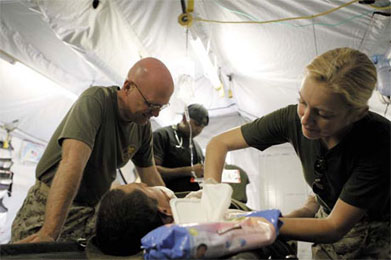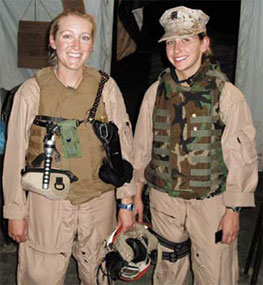| Transformed by education | Images of a championship season | Alumna saves lives in Iraq |
 |
||
| Home Forethought Campus Buzz Feature Stories Re:Search The Score Alum News Yesteryear | ||
Ensign Kelly Bowman had finished for the day as a critical care nurse at Camp Taqaddum, 35 miles west of Baghdad. She was exhausted and ready for a break from the 24/7 demands of hospital work in a war zone. She was saying her goodbyes when a mortar shell exploded in the tent four down—too close for comfort for a nurse from Texas who was finally going home.
 |
| For more than six months in Iraq, Kelly Bowman ('03) worked on a mobile trauma surgical team that could be fully operational in an hour and care for up to 18 wounded soldiers for two days without relief. |
Bowman, a 2003 UTA School of Nursing graduate, spent a little more than six months, from August 2003 to March 2004, stationed with a Marine wing element somewhere between Fallujah and Ramadi—two areas with large insurgency populations bent on killing Americans. She wore full protective gear around the clock, and the sound of gunfire and mortar shells became routine.
“The insurgents were constantly firing on the flight line,” she recalls. “We were impacted 135 times in the six months—that’s rounds that actually exploded, not the duds.”
Her platoon was an FRSS (Forward Resuscitative Surgical Systems) unit, a highly mobile, rapidly deployable trauma surgical team. It can be ready in 60 minutes to provide care for up to 18 wounded soldiers for 48 hours without resupply or relief. An FRSS consists of one anesthesiologist, two general surgeons, one critical care nurse, one en route care nurse, one physician assistant, two surgical techs and one corpsman. It provides immediate medical attention to injured soldiers, civilians and enemy prisoners of war, using a “life over limb over eyesight” philosophy.
“We’re damage control,” says Bowman, who is fourth-generation military. “We stop the bleeding, get them stabilized and move them out in no more than 12 hours.”
Bowman’s role on the team was unique, serving as an en route critical care nurse, a designation new to this war. Previously, patients stabilized at an FRSS could die while being taken to a higher-echelon medical facility. It was determined that a seasoned critical care nurse could fly in the evacuation helicopter and provide constant care to maintain patient stability, including blood transfusions, ventilators to assist breathing and intravenous medication.
Bowman was one of four nurses in this capacity at Camp Taqaddum. In six months, she assisted 36 patients in 26 flights from Taqaddum to medical facilities in Baghdad and Balad. She saw one gunshot victim die en route and had one extubation—the ventilator tube, which enabled the patient to breathe, came out—due to high wind while in flight. Flights lasted 30-45 minutes, depending on destination, and were fraught with challenge as the helicopters weaved and banked to avoid enemy fire.
“The vibrations were so bad that the equipment couldn’t read the patient’s vital signs,” she says. “It was a crapshoot, guessing what would keep the patient alive.”
 |
| Stationed with a Marine wing element somewhere between Fallujah and Ramadi, Bowman, left, and fellow nurse Gini Hinrichs manage a few smiles despite nearby gunfire and mortar shell explosions. |
When Bowman wasn’t in the air, she offered critical care nursing for patients on the ground at the FRSS. The team saw more than 735 patients in six months, and doctors performed more than 350 surgeries in less than ideal conditions.
The power generators would break down; the heaters that kept patients warm would quit. It’s hot in Iraq from September to November, then cold from December to March.
One patient Bowman remembers in particular, an Army captain, was injured when his convoy vehicle hit an improvised land mine. The explosion broke his leg and drove shrapnel, dirt and debris into his body.
“We did surgery and pulled a four-inch piece of metal out of his leg. We gave him blood and then evacuated him. We had to move him or he would die.”
Bowman traveled with the captain, giving him blood and medications to keep him stable. He survived the trip. She later learned that his leg was amputated and that he was receiving additional treatment in the United States.
The team saw more patients in November as U.S. forces pushed on Fallujah, an insurgent stronghold. The offensive began Nov. 8; 38 U.S. soldiers were killed and 275 wounded over the next five days.
“We were balls to the wall. Surgery around the clock, mass casualties inbound in the middle of the night. We saw 150 patients in five days. I slept 10 hours.”
One night, a call came that five injured troops were inbound. Bowman waited for the light-armored vehicles that carried them. When the ambulance arrived, she opened the door and blood dripped out. She saw two patients with extensive injuries and immediately recognized the insignia on the collar of one. He was a doctor, injured when a vehicle driven by a suicide bomber struck the ambulance he was riding in.
He had multiple fragment injuries all over, as well as bilateral tibia-fibula fractures. He was treated and then evacuated. Now he is recovering and should be a “regular doctor” again soon, Bowman says.
Bowman returned home in March 2004. Stationed in San Diego, she’s working as a labor and delivery nurse but moves back to emergency room care in June. She visited UTA in early April and spoke with nursing students and faculty about her experiences in Iraq.
“We are so proud of the work Kelly did for the sake of our soldiers,” says Associate Professor Wendy Barr, who taught Bowman in a clinical nursing course and invited her to speak on campus. “There was never any doubt that she would serve her country without regard to her own personal safety.”
Bowman intends to volunteer to return to Iraq in 2006—she understands how badly nurses are needed—although she hopes the trip will be calmer. On her first ride to Baghdad, she flew in business class to Kuwait. Then she took a military transport into Iraq on tactical approach.
“We dropped about 9,000 feet in three seconds while doing this twirling thing all the way down.”
After she completes her term of service, she plans to enroll in UTA’s graduate nursing program in 2007—and enjoy the peacefulness of her native Texas.
— Becky Purvis
| Archives
| Alumni Association |
Giving to UTA | UTA
Home Copyright © 2005 UTA Magazine. All rights reserved. |